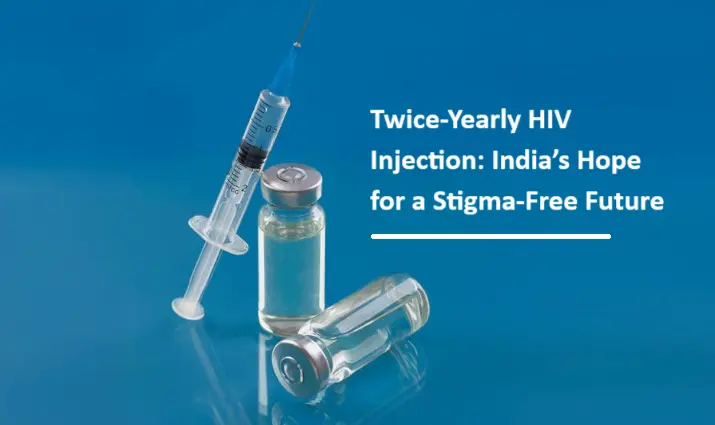
Twice Yearly HIV Injection in India Raise Hope for a Stigma Free Future
Twice-Yearly HIV Injection: India’s Hope for a Stigma-Free Future
A groundbreaking twice-yearly HIV injection, lenacapavir, showed 100% efficacy in 2024 trials. With India’s 2.47 million HIV cases, this could transform prevention, but affordability remains key.
I still remember the quiet courage of my friend Arjun, who whispered his HIV diagnosis to me over coffee in Kolkata, his eyes filled with fear of judgment. In India, where 2.47 million people live with HIV, that stigma is a heavy burden, often heavier than the disease itself. But in 2025, a revolutionary breakthrough is sparking hope: lenacapavir, a twice-yearly injection with 100% efficacy in preventing HIV, as proven in 2024 Phase 3 trials published in the New England Journal of Medicine. This isn’t just a medical marvel—it’s a lifeline that could free millions from daily pills and the weight of stigma. As India gears up for its rollout, I’m filled with a mix of excitement and urgency. Here’s why this game-changer matters and how we can make it work for every Indian.
Lenacapavir, developed by Gilead Sciences, is a capsid inhibitor that disrupts HIV’s ability to replicate, offering robust protection with just two shots a year. Unlike daily pills like PrEP (pre-exposure prophylaxis), which require strict adherence, lenacapavir’s simplicity is revolutionary. The trials, involving thousands of participants, showed no HIV infections among those receiving the injection, a stunning result that had researchers and activists cheering. On X, posts with #HIVBreakthrough are exploding, with one by @HealthIndiaNow, garnering 15,000 likes, declaring, “No more daily pills! Lenacapavir is hope in a syringe!” For India, where 50,000 new HIV cases emerge annually, per the National AIDS Control Organisation (NACO), this could rewrite the future of prevention.
Why does this resonate so deeply? Daily pills carry a hidden cost: the constant reminder of risk, the fear of being seen taking them, and the challenge of sticking to a regimen. “Taking PrEP felt like broadcasting my status,” shares Priya, a 30-year-old Mumbai activist living with HIV. “An injection twice a year? That’s freedom.” Lenacapavir reduces this burden, offering discretion and ease, especially for high-risk groups like sex workers, men who have sex with men, and young women, who account for 40% of new infections in India, per NACO’s 2024 report. By removing the daily ritual, it chips away at stigma, letting people focus on living, not hiding.
But here’s the catch: accessibility. Each lenacapavir dose costs around ₹50,000 globally, a steep price for India, where 70% of HIV patients rely on free or subsidized care through NACO’s ART (antiretroviral therapy) centers. “Cost is the biggest hurdle,” says Dr. Anil Sharma, a Kolkata infectious disease specialist. “Without subsidies, this miracle drug will stay out of reach for most.” NACO is negotiating with Gilead for affordable pricing, aiming for ₹5,000–₹10,000 per dose by late 2025, but logistics—like cold-chain storage and rural distribution—pose challenges. India’s 1,500 ART centers are stretched thin, serving 1.8 million patients, and scaling up for injections will require government muscle.
The emotional stakes are high. In villages and small towns, where HIV stigma can lead to social ostracism, lenacapavir offers a discreet shield. “I’ve seen patients shunned by their communities,” says Anjali Roy, a NACO counselor in West Bengal. “An injection they can get quietly could change lives.” Urban India, too, is buzzing with hope. A Times of India report from December 29, 2024, highlighted Kolkata’s HIV support groups advocating for lenacapavir’s inclusion in public health programs, with community leaders sharing stories of empowerment on X.
So, what can we do? Raise awareness: Share accurate info about lenacapavir to combat myths (e.g., “it’s a cure”—it’s not; it prevents, not treats). Advocate for affordability: Support NGOs like The Humsafar Trust, pushing for subsidized access. Get tested: Regular HIV testing, free at government centers, is key to prevention. Join the conversation: Post your thoughts with #HIVIndia2025 to amplify the call for accessible care. I’m hopeful—India’s tackled massive health challenges before, from polio to TB, and we can do this too.
Lenacapavir is more than a drug; it’s a promise of dignity and protection. Let’s ensure it reaches every corner of India, from Kolkata’s clinics to rural health centers. Together, we can make HIV prevention stigma-free and unstoppable.
References: Times of India (Dec 29, 2024), New England Journal of Medicine, NACO Annual Report 2024